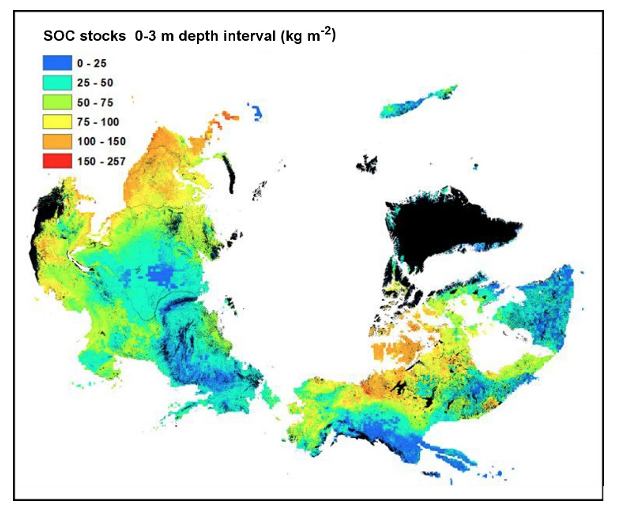March 05, 2021
New Estimates of Carbon Storage in Permafrost-Region Soils
Big data and geospatial analysis generated high-resolution estimates of soil organic carbon stocks for permafrost regions of the northern hemisphere.

Predicted spatial distribution of soil organic carbon (SOC) stocks to a depth of three meters for the northern circumpolar permafrost region.
[Reprinted under a Creative Commons Attribution 4.0 International License (CC BY 4.0) from Mishra, U., et al. “Spatial heterogeneity and environmental predictors of organic carbon in permafrost region soils,” Science Advances 7, eaaz5236 (2021). DOI: 10.1126/sciadv.aaz5236]
The Science
The first high-resolution maps of soil organic carbon distributions for the northern hemisphere permafrost region were produced by combining over 2,700 field measurements with spatially explicit information on environmental factors that influence soil formation. Geospatial analysis identified dominant environmental predictors of soil carbon quantities and their uncertainties in different geographic areas and for sequential depth intervals to 3 meters below the surface. Total regional carbon amounts were similar to earlier assessments, but access to new observational data, coupled with geospatial prediction methods, provided new insight into the spatial patterns and depth distributions of carbon storage across the region.
The Impact
Anticipated warming in permafrost regions is likely to increase the rates of greenhouse gas emissions produced by decomposition of the large organic carbon stocks that have accumulated in regional soils. This updated assessment of regional carbon distributions suggests more carbon is stored closer to the surface (where it is more vulnerable to top-down warming) than previously thought. The new spatially explicit organic carbon estimates will provide a crucial benchmark for improving the representation of high-latitude carbon stocks in land surface models used to predict changes to the global carbon cycle and resulting feedbacks to future climate.
Summary
Large organic carbon stocks have accumulated in soils of the northern hemisphere permafrost region, but their current magnitude and future fate remain uncertain. Scientists coupled a new database of soil profile observations with a high-resolution dataset of environmental factors in a geospatial framework to generate spatially explicit estimates of permafrost-region soil carbon stocks, quantify prediction uncertainties, and identify key environmental predictors. The team estimated 1,014 Pg C is stored in the top 3 meters of northern hemisphere permafrost-region soils. Although the total amount is slightly lower than earlier estimates, this new assessment suggests more carbon is stored within a meter of the surface and thus is more vulnerable to top-down warming. The greatest prediction uncertainties occurred in toe-slope positions of the northern circumpolar region and in flat areas of the Tibetan region. Soil wetness and elevation were the dominant topographic controllers of soil carbon stocks. Significant climatic controllers were surface air temperature in the circumpolar region and precipitation in the Tibetan region. The study produced the first high-resolution geospatial assessment of permafrost-region soil organic carbon stocks and their relationships with environmental factors. Such information is crucial for modeling efforts to predict the responses of permafrost-affected soils to changing climatic conditions.
Principal Investigator
Julie Jastrow
Argonne National Laboratory
jdjastrow@anl.gov
Program Manager
Daniel Stover
U.S. Department of Energy, Biological and Environmental Research (SC-33)
Environmental System Science
daniel.stover@science.doe.gov
Funding
This work was supported by the U.S. Department of Energy, Office of Science, Office of Biological and Environmental Research, Earth and Environmental Systems Sciences Division, under contract DE-AC02-06CH11357 to Argonne National Laboratory.
Related Links
References
Mishra, U., et al. "Spatial heterogeneity and environmental predictors of organic carbon in permafrost region soils." Science Advances 7 eaaz5236 (2021). https://doi.org/10.1126/sciadv.aaz5236.

